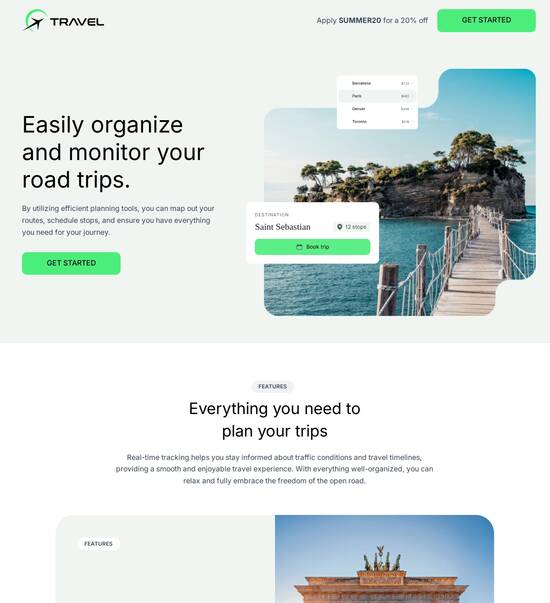
Laravel optimized welcome page template
Explore Similar TemplatesAbout template
Supercharge your welcome page with Laravel for outstanding performance! Learn more today.
Recommended templates

Easy to build without coding
With the intuitive drag-and-drop builder, anyone on your team can create high-converting pages without any knowledge of code or design. Make enhancements to your landing page with custom widgets using Javascript, HTML/CSS, or third-party scripts.

Multiple layouts for any industry and goal
Select from 500+ landing page layouts built to boost conversions across industry-specific scenarios. Customize them by adjusting fonts, adding images, and generating on-brand content with the AI assistant. Quickly scale with Instablocks® and Global Blocks that you can save, reuse, and update globally.

Loads fast and looks polished on any device
Every template is responsive, which means they present professionally on any device and load blazingly fast with our Thor Render Engine. You can also power them up with Google AMP technology to deliver an unparalleled mobile experience and drive higher conversions.

Robust analytics & experimentation
Get real-time updates and reporting across all your devices, showing the number of visitors, conversions, cost-per-visitor, and cost-per-lead. Launch AI-powered experiments, run A/B tests, and use heatmaps to analyze user behavior, then optimize your landing page to maximize conversions.







Easy to build without coding
With the intuitive drag-and-drop builder, anyone on your team can create high-converting pages without any knowledge of code or design. Make enhancements to your landing page with custom widgets using Javascript, HTML/CSS, or third-party scripts.
Multiple layouts for any industry and goal
Select from 500+ landing page layouts built to boost conversions across industry-specific scenarios. Customize them by adjusting fonts, adding images, and generating on-brand content with the AI assistant. Quickly scale with Instablocks® and Global Blocks that you can save, reuse, and update globally.
Loads fast and looks polished on any device
Every template is responsive, which means they present professionally on any device and load blazingly fast with our Thor Render Engine.
Robust analytics & experimentation
Get real-time updates and reporting across all your devices, showing the number of visitors, conversions, cost-per-visitor, and cost-per-lead. Launch AI-powered experiments, run A/B tests, and use heatmaps to analyze user behavior, then optimize your landing page to maximize conversions.
All the features you need to build laravel landing page template
Explore more featuresLearn how to build top-performing landing pages for any goal
FAQs
Leading the way in building high-performing landing pages





Maximize your ROI with Instapage's powerful landing page platform
Instapage provides a robust solution for marketers looking to enhance their digital campaigns. With features tailored for various sectors such as business services, education, and financial services, Instapage empowers teams to create high-converting landing pages effectively. Utilizing cutting-edge tools, this guide will walk you through how to leverage Instapage for optimal campaign performance.
Understanding Instapage and its value proposition
As an all-in-one landing page and conversion rate optimization (CRO) platform, Instapage helps marketers streamline their campaign efforts. From advanced templates to detailed analytics dashboards, its array of features ensures high adaptability and exceptional results regardless of your campaign scale or design experience.
- Pre-built templates: Access over 100 ready-to-use templates designed to capture leads and convert visitors effectively.
- Analytics and heatmaps: Gather insights on user behavior to make informed decisions on landing page optimization.
- Personalization features: Customize experiences for different audience segments to improve engagement and conversion rates.
Step 1: Create your first landing page
Begin by utilizing the user-friendly interface Instapage offers, which allows you to build a landing page without needing coding skills. Choose a template that aligns with your campaign goals.
Step 2: Optimize for conversions
Once your landing page is set up, it's crucial to focus on optimization for higher conversions. Here are several strategies to incorporate:
- A/B testing: Experiment with different headlines, images, and calls-to-action to discover what resonates best with your audience.
- Utilize dynamic text replacement: Automatically personalize your landing pages to match the keywords potential customers are searching for.
- Implement heatmaps: Understand where visitors click and focus on areas needing improvement.
Step 3: Leverage collaboration features
Engage your team and stakeholders effectively while creating landing pages using Instapage's collaboration features. Ensure that everyone is on the same page by sharing drafts and gathering real-time feedback.
- Instant feedback tools: Receive comments and suggestions directly on your live pages.
- Real-time edits: Collaborate seamlessly and implement changes immediately based on team discussions.
- Secure sharing: Collaborate with stakeholders while keeping your landing pages secure and private.
Instapage not only simplifies the process of creating landing pages but also enhances the functionality of your marketing strategies with insightful tools and collaborative features.
Ready to transform your campaign performance? Start using Instapage today to create impactful landing pages that drive results!
Laravel optimized welcome page template
The Laravel ecosystem: Building blocks of an optimized welcome page template
Laravel is a powerful PHP framework, well-regarded for its expressive syntax and robust ecosystem. With a dedicated developer community, Laravel continually evolves to meet modern web development demands, making it a preferred choice for creating dynamic web applications. When it comes to optimized welcome pages, Laravel's architecture and features provide the foundation necessary for building efficient and effective templates.
Understanding Laravel's unique framework
### A brief overview of Laravel Laravel was introduced by Taylor Otwell in 2011, aiming to make web development more enjoyable and efficient. Since then, Laravel has undergone significant changes and improvements, becoming one of the most popular PHP frameworks in the world. Its MVC (Model-View-Controller) architecture separates application logic from UI, which is crucial for developing modular, maintainable web applications.
### Key features that position Laravel as a development powerhouse Laravel's features contribute to its appeal: - **Eloquent ORM**: An elegant ActiveRecord implementation for working with your database, allowing you to work with database records using a clean, expressive API. - **Blade templating engine**: This powerful templating engine facilitates dynamic content rendering with a simple syntax, enabling developers to compose reusable components effectively. - **Route management**: Laravel offers an intuitive routing system that allows for clean and straightforward URL handling.
The importance of an optimized welcome page template
### Defining the welcome page: More than just a first impression A welcome page serves as an initial touchpoint for visitors. It shapes their first experience with your brand and can significantly influence user engagement. An effective welcome page goes beyond aesthetics; it showcases essential information, guides users to take desired actions, and effectively communicates your value proposition. Implementing optimal strategies on the welcome page can lead to better conversion rates and improved user engagement.
### Performance metrics that matter When developing an optimized welcome page, certain performance metrics are vital for assessing its effectiveness. Key metrics include page load speed, which impacts user retention—faster load times lead to lower bounce rates. Additionally, conducting A/B testing offers invaluable insights into user behavior, enabling developers to experiment with different designs and content to see what resonates best with the audience.
Mechanisms behind Laravel optimized welcome page templates
### Leveraging Blade and components for efficiency Laravel's Blade templating engine allows for efficient development of welcome pages through reusable components. By creating components for repeated sections—like headers, footers, and call-to-action areas—developers can ensure consistency across various templates. Moreover, Blade enables dynamic data binding, which enriches the user experience by allowing real-time data updates on the welcome page.
### Understanding Laravel Mix: Asset compilation To streamline asset management, Laravel Mix provides a clean API for compiling CSS and JavaScript files. By utilizing Laravel Mix, developers can manage their assets effortlessly, ensuring that styles and scripts are optimized and minified for better loading times. By combining multiple files into one, you reduce HTTP requests, leading to faster performance—critical for engaging users from the moment they land on your welcome page.
### Middleware: Managing incoming requests effectively Middleware plays a key role in Laravel applications by managing incoming requests and responses. Through middleware, developers can implement authentication, logging, and performance optimizations seamlessly. Additionally, creating custom middleware for analytics tracking can provide insights into user interactions on the welcome page, allowing for ongoing enhancements based on real data.
Essential technologies enabling enhanced welcome pages
### Frontend technologies that complement Laravel To maintain modern user expectations, integrating frontend technologies into your Laravel application is essential. Using Vue.js enables the creation of reactive components, providing users with real-time updates and interactions without requiring page reloads. Additionally, employing Tailwind CSS can dramatically improve the design of your welcome page by providing utility-first styles that enhance responsiveness and ease of customization.
### The integration of APIs: Fetching dynamic content APIs can enrich the user experience on your welcome page by enabling dynamic content fetching. By utilizing RESTful services, you can display real-time data, such as current promotions or user-specific content. However, securing these API endpoints should be a priority to safeguard user information and ensure reliable service, following best practices like authentication and rate limiting.
Engaging community and developer ecosystem
### Harnessing community knowledge and support The Laravel community is vast and continually active. Engaging with online forums and GitHub collectives is a fantastic way to connect with other developers. Sharing experiences and solutions enriches the entire community, offering newcomers access to valuable insights. Open-source contributions are also significant, allowing developers worldwide to learn from each other while pushing Laravel's evolution forward.
### Insightful Q&A platforms for developer queries When facing challenges, platforms like Stack Overflow provide a wealth of knowledge for Laravel-specific inquiries. Searching existing threads can often yield quick answers, while asking new questions allows for targeted help. Additionally, joining Laravel-based Discord servers and Slack channels can facilitate real-time discussions and networking opportunities, leading to enhanced learning and collaboration.
Crafting compelling content for your welcome page
### The art of writing effective copy Landing pages benefit significantly from well-crafted copy. Key elements include clarity, relevance, and persuasion. Utilize short, impactful headlines that draw users in and address their needs. Employing a clear messaging strategy, along with a logical visual hierarchy within content, not only assists users in navigating your page but also directs them towards key actions, maximizing conversion opportunities.
### Best practices for stellar visual design In terms of visual design, consistency is paramount for branding. All elements on your welcome page should align with your overall brand identity. Using imagery and video can further enhance user engagement—compelling visuals can convey emotions and messages more effectively than text alone. It's essential to test various design components to find the optimal layout that resonates with your audience.
The development workflow: Tasks and tutorials
### Setting up your Laravel environment For a productive workflow, begin by setting up your local Laravel environment. This involves installing necessary tools, including Composer, Laravel Installer, and a local server like Valet or Homestead. A step-by-step task guide will have you up and running in no time. Once your local environment is set up, consider hosting solutions that align with your team’s growth and scaling needs.
### Building an optimized welcome page: From idea to reality Transforming ideas into a functioning welcome page requires a structured approach. Initially, wireframe your design to layout how content and features will be displayed. Then, iterate through development stages, focusing on testing and debugging throughout the process. A focus on user experience will ensure that the final product is both engaging and efficient.
Accessing and utilizing previews
### Tools for previewing changes and layouts Tools like Laravel’s built-in server enable developers to preview changes locally. This functionality is essential for testing design and functionality before deploying changes live. Third-party services further assist in responsive design testing across various devices, ensuring your welcome page looks and operates efficiently on every screen size.
### Real-time collaboration tools for development teams Collaboration is integral to modern development. Utilizing version control systems like Git ensures smooth collaboration among team members, allowing for effective tracking of changes. Furthermore, leveraging pair programming platforms enhances efficiency and communication within development teams, fostering a more cohesive work environment.
Exploring user views: Collecting feedback and data
### Analytics integration: Understanding user interaction Integrating analytics tools such as Google Analytics or Laravel Telescope provides developers with essential information about user interactions on their welcome pages. Monitoring traffic sources, user behavior, and conversion rates enables a deeper understanding of how users engage with content, guiding future updates and optimizations to enhance overall performance.
### Feedback mechanisms: Gathering insight for enhancements To continuously improve the user experience, design feedback mechanisms such as surveys or user feedback forms. This allows users to share their thoughts, helping developers identify areas for enhancement. Utilizing an iterative design approach ensures that future updates are aligned with user needs, driving the platform's evolution forward.
Common questions and misconceptions about Laravel welcome pages
### Addressing frequent queries from new developers Many new developers may be daunted by Laravel's flexibility, leading to misconceptions about its complexity. However, Laravel's extensive documentation and community resources help demystify the framework. Customizing templates is very much achievable, and fostering a mindset of exploration leads to deeper learning and proficiency.
### Expert insights: Overcoming common development challenges Real-world challenges, such as database migrations or routing conflicts, can arise during development. However, seasoned developers recommend a step-by-step approach to troubleshooting, leveraging the community for support. Observing common patterns can guide new developers in navigating obstacles effectively, promoting a culture of continuous learning and adaptability.
Ready to skyrocket conversions?
Supercharge your ad campaigns with high-performing landing pages
Get started














